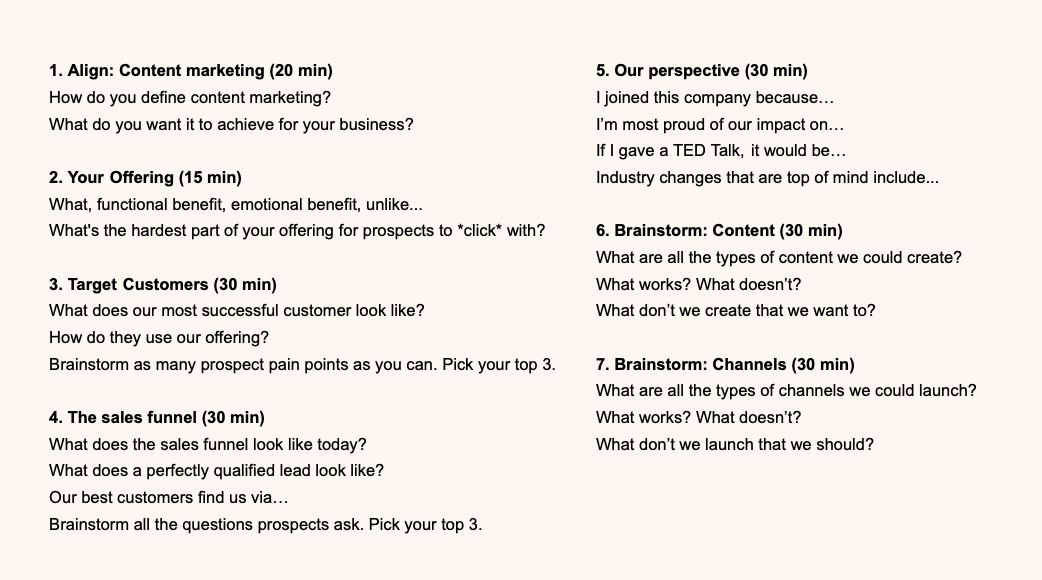Content Strategy Workshops: How I Create & Run My Workshops for Clients
/Research is the most important part of any content strategy project.
As a strategist, it’s not your job to come up with amazing ideas of all the cool things you could do.
It’s your job to listen, synthesize, and mirror what I find in your strategy.
My favorite way to do this is through a content strategy workshop.
I’ve expanded on my approach to workshops below, sharing how I format, create, and run my favorite form of research.
It’s one of the 12 templates in my Ultimate Content Strategy Toolkit, which you can download for $299.
What is a content strategy workshop?
There are countless ways to hold a workshop. Here’s mine.
I gather together key content stakeholders at the company for 2-4 hours. Together, we share our perspectives on the state of content at the business.
My goal is to learn what is working, what isn’t, and what they’d like to change.
I’m also trying to uncover misalignments — where people are thinking differently about something.
Why do I want to learn these things? They’ll inform my content strategy, which ultimately helps the business:
Further improve what’s already working
Drop or pivot what isn’t working
Align around the company’s updated approach to content
Clients agree. Here’s what a client recently said about our workshop together.
WHAT IS INCLUDED?
I like my workshops to follow this structure:
I ask a question or prompt.
Participants spend a few minutes answering the prompt in their workbook.
We all discuss.
We move on to the next prompt.
HOW DO I CREATE A CONTENT WORKSHOP?
STEP 1: Identify who needs to be there.
I try to keep the group to 7 project stakeholders, max. Five people is the sweet spot.
“Stakeholders” can mean people like:
Business leaders (CEO, COO, General Manager). They can speak to the business’s goals at large.
Marketing leaders who can speak to marketing’s goals and how content fits into them.
Content producers, writers, and managers who can speak to the day-to-day.
Someone from the growth marketing, sales team, or any other team that relies on content to be successful.
STEP 2: Get those stakeholders involved
Everyone is busy. I get it. Asking people to take time for a 2- or 3-hour workshop is… a lot.
I find that stakeholder participation works best if it’s requested from the leader (CEO or head of marketing) first. Then, I can uphold that request.
For example, I’ll work with the head of marketing to identify who should join the workshop. I’ll ask the leader to brief each stakeholder on my project and the workshop, telling them to expect more details from me shortly. Then, I’ll follow up individually with the details of involvement.
STEP 3: Figure out what topics are most important to learn about
My master list includes:
Your offering
Target customers
The sales funnel
Our perspective
Content brainstorm
I pick 3ish topics that are particular pain points for the company.
I always, always want to cover more. But it’s critical that workshop attendees don’t feel rushed, and there’s plenty of space to explore and discuss.
STEP 4: Identify the prompts
I pick from questions I’ve learned work well for my workshops. They’re all included in my workshop template in my content strategy toolkit.
Prompts most often include:
Answering a question
Brainstorming a list
Finishing a sentence
Here is an overview of the prompts I’ll ask for each topic.
STEP 5: Build your workshop presentation
Once I’ve identified the prompts, I place them into a simple deck. I’ll share my screen with each prompt during the workshop.
I also include in my deck:
An overview of why we’re here and what we’re trying to solve
An overview of how the workshop will work
Any “housekeeping” notes, such as when breaks will take place
I like to spend about 10 minutes at the beginning of each workshop walking through these points.
STEP 6: Time out the agenda
I familiarize myself intimately with how long I’d like each question to take. For example, should we take 3 minutes to answer this question and 10 to discuss?
I add it all up. Am I falling around the total time of the workshop? Do I have a little wiggle room in case discussions take a long time?
I also identify the optional questions. If the conversations are flowing, I would rather skip a question than rush people through their thinking.
This way, I can easily track and adjust our progress during the workshop itself.
STEP 7: Send an agenda
My agendas are mostly about setting expectations: Bring an open mind and be willing to share your opinions.
STEP 8: Once we’re together and about to start, we build the workbooks together
At the beginning of each workshop, I ask people to create a blank Google Doc and share it with me. Or, I’ll create a simple workbook and share the link.
I like to have participants fill out answers privately in their workbooks before discussing.
Otherwise, I find participants may hold back an answer they deem “wrong” if someone else has spoken before them.
It’s also helpful for me to have their notes after the fact. Then, I can be more present while facilitating.
STEP 9: Hold the workshop
It’s go time! The heavy lifting is done.
My job during the workshop is to listen closely and facilitate conversation.
I need to:
Encourage everyone to take part
Softly prod people or push for more detail
Facilitate conflict
Let silences linger (the best answers come after an awkward pause)
If you’d like the template of my content strategy workshop, please consider my toolkits.



